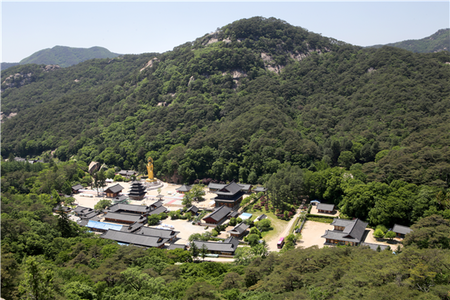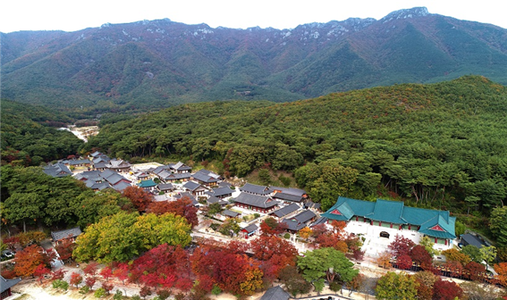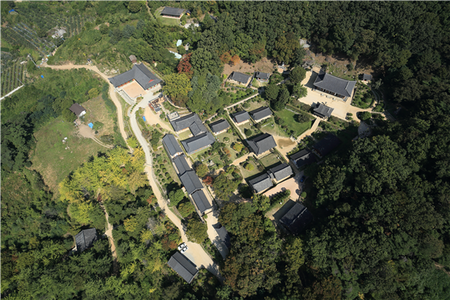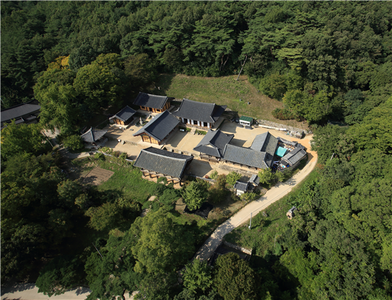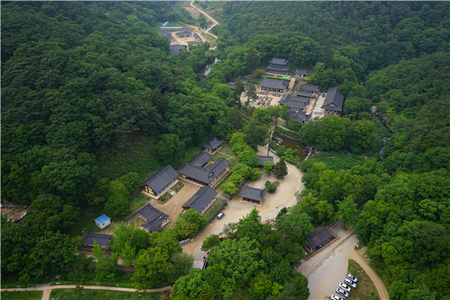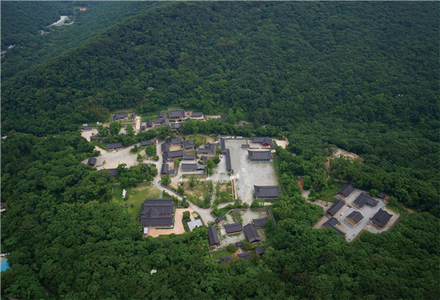산사, 한국의 산지승원
| 산사, 한국의 산지승원 Sansa, Buddist Mountain Monasteries in Korea |
|
| 대표명칭 | 산사, 한국의 산지승원 |
|---|---|
| 영문명칭 | Sansa, Buddist Mountain Monasteries in Korea |
| 한자 | 山寺, 韓國의 山地僧院 |
| 웹사이트 | 산사, 한국의 산지 승원/Sansa, Buddist Mountain Monasteries in Korea |
종합안내판
산사는 한반도 남쪽 지방에 위치한 통도사, 부석사, 봉정사, 법주사, 마곡사, 선암사, 대흥사 7개 산지승원을 일컫는 것이다.
7세기에서 9세기에 창건된 이들 7개 사찰은 신앙과 수행, 일상생활을 중심으로 한 한국 불교의 역사적인 발전 모습을 보여 준다. 또한 한국 선불교의 특징인 자급자족이 가능한 사찰 관리, 승려 교육, 수행과 교리 학습뿐만 아니라 한국 불교의 무형적, 역사적 측면도 확인할 수 있다. 경내에는 한국의 다양한 불교신앙이 수용되어 있으며, 역사적으로 중요한 다수의 구조물과 전각, 유물, 문서 등은 한국 불교의 포용적 특성을 잘 반영하고 있다. 산사는 조선시대 억압과 전란으로 많은 손상을 입었다. 그러나 오늘날에도 신성한 장소로서, 신앙과 일상적인 종교적 실천이 살아 있다.
Sansa, Buddhist Mountain Monasteries in Korea
Sansa, meaning "mountain monasteries" in Korean, refers to Buddhist temples located in mountainous areas. Here, communities of monastics and lay believers have carried out Buddhist traditions of spiritual practice, religious worship, and daily living until the present day. Seven renowned mountain monasteries were inscribed as a group on the UNESCO World Heritage List in 2018. The group consists of Tongdosa Temple, Buseoksa Temple, Bongjeongsa Temple, Beopjusa Temple, Magoksa Temple, Seonamsa Temple, and Daeheungsa Temple, which are distributed across the southern provinces of the Republic of Korea.
These seven temples flourished from the 7th to the 9th centuries and served as centers of religious belief, spiritual practice, and daily living of monastic communities. Since their establishments, the temples have continuously conducted religious services, rites and ceremonies, teaching, and monastic practices based on Buddhist belief introduced through China, while also incorporating diverse native beliefs. Their notable historic structures, worship halls, objects, and documents reflect the unique character of Korean Buddhism. Despite suppression during the Joseon dynasty (1392-1910) and damage caused by wars and conflicts over the years, these mountain monasteries stand as sacred places, which have survived to the present as embodiments of the historical development of Buddhism in Korea.
산사, 한국의 산지승원 세계유산 등재 과정
- 2013. 12. 17.: 한국의 전통 산사 잠정목록 등재
- 2015. 3. 12.: 한국의 전통 산사 우선 추진 대상 선정
- 2017. 1.: 유네스코 세계유산 등재 신청서 제출(명칭: 한국의 전통 산사→산사, 한국의 산지승원)
- 2017. 9. 11 ~ 9. 16: 이코모스(ICOMOS) 현지 실사
- 2018. 7. 4.: 산사, 한국의 산지승원 세계유산 등재
- 이코모스(ICOMOS): 국제기념물위원회, 유네스코세계유산위원회 자문기구
Process for Inscription on the World Heritage List
- Dec. 17, 2013: Officially inscribed on the Tentative List of UNESCO World Heritage
- Mar. 12, 2015: Selected for priority inscription
- Jan. 27, 2017: Application submitted
- Sep. 11-16, 2017: Surveyed and evaluated by ICOMOS
- Jul. 4, 2018: Officially inscribed by UNESCO
- The International Council on Monuments and Sites (ICOMOS) is the official advisor to UNESCO on matters related to World Heritage Sites.
사찰별 안내판
법주사
법주사는 충청북도 보은군에 있는 사찰로, 미륵신앙의 전당인 산호전을 중심으로 8세기 중반에 창건되었다.
현재는 산호전 자리에 미륵대불이 조성되어 있으며, 이는 석가 신앙의 대웅보전과 두 개의 축으로 이루어져 직교하도록 구성되었다. 경내에는 한국 유일의 목탑 형식 건물인 팔상전과 중층 법당을 대표하는 목조 건축물인 대웅보전이 보존되어 있다. 이 산사는 넓은 산지에 마당을 중심으로 야외 예불 공간이 펼쳐져 있다.
- 553년 의신조사가 창건하고, 766년 진표율사가 중창하였다고 함.(http://www.koreansansa.net/ktp/sansa/sansa_020301.do)
Beopjusa Temple
Beopjusa Temple, located in Songnisan Mountain in Boeun, Chungcheongbuk-do, was originally established in 553 and was renovated and expanded by many of Korea's most renowned monks. The entire temple was once completely destroyed during the Japanese invasion of 1592-1598, and its reconstruction began in 1624.
The temple preserves typical characteristics of a mountain monastery, which consists of areas for meditation and daily life of its monks. Palsangjeon Hall, which enshrines paintings of the Eight Great Events from the life of Buddha, is the only extant wooden pagoda in Korea.
통도사
통도사는 경상남도 양산시에 위치한 사찰로, 신라 선덕여왕 15년(646) 자장율사가 창건하였다. 통도사는 삼원체제(三院體制)로 분립된 가람 배치를 지니고 있는데, 석가모니 부처님의 진신사리를 봉안한 ‘금강계단(金剛戒壇)’을 중심으로 상·중·하로전이 있다. 특히 7세기 산지승원의 특징뿐만 아니라, 수행과 신앙의 시대적 변천 과정을 고스란히 담고 있다.
이 산사는 석가여래의 진신사리를 비롯한 4만여 점에 이르는 성보유물(聖寶遺物)과 600여 점에 달하는 불화(佛畫), 글씨 등을 보존하고 있는 ‘불보의 종찰(佛寶宗刹)’이자 ‘민족문화유산의 보고(寶庫)’이다.
Tongdosa Temple
Tongdosa Temple, located in Yeongchuksan Mountain in Yangsan, Gyeongsangnam-do, was established in 646 by Jajang (590-658), an eminent monk of the Silla kingdom (57 BCE-935 CE). It is said that Jajang brought the true remains of Sakyamuni Buddha from Tang China in 646 and built the ordination platform of this temple to enshrine the remains.
The defining characteristic of Tongdosa Temple is its spatial composition, consisting of separate areas for daily life, worship, and meditation, which is well preserved in its traditional form. The temple is also home to numerous Buddhist cultural heritage, including about 40,000 relics and 600 Buddhist paintings.
부석사
부석사는 경상북도 영주시에 있는 사찰로, 신라 문무왕(文武王) 16년(676) 해동(海東) 화엄종(華嚴宗)의 종조(宗祖)인 의상 대사(義相大師)가 왕명(王命)으로 창건한 화엄종의 수사찰(首寺刹)로 우리나라 화엄사상의 발원지이다.
부석사로 불리우게 됨은 무량수전(無量壽殿) 서쪽에 큰 바위가 하나 있는데 이 바위는 아래의 바위와 서로 붙어있지 않고 떠 있어서 ‘뜬 돌’이라 한데서 연유한다.
무량수전은 우리나라 최고(最古)의 목조건물 중 하나이며, 조사당벽화는 목조건물에 그려진 벽화 중 가장 오래된 것이다.
Buseoksa Temple
Buseoksa Temple, located in Bonghwangsan Mountain in Yeongju, Gyeongsangbuk-do, was established in 676 by Uisang (625-702), a great monk of the Silla kingdom (57 BCE-935 CE). Uisang founded the Korean Avatamsaka sect of Buddhism under the patronage of King Munmu (r. 661-681). Thereafter, this temple became the headquarters of the Korean Avatamsaka sect, contributing to the development of the doctrine in Korea.
The temple's main worship hall, Muryangsujeon, is one of Korea's oldest extant wooden buildings, which was repaired in the 14th century. The temple is also renowned for the murals painted on the walls of Josadang Hall, which are the oldest of their kind painted on a wooden building in Korea.
봉정사
봉정사는 경상북도 안동시에 있는 사찰로, 672년(문무왕 12) 능인대사가 창건한 고찰이다. 능인대사가 터를 정하기 위해 종이 봉황을 접어 날렸는데 지금의 자리에 머물렀다고 하며, 사찰의 이름도 여기에서 유래되었다고 전해진다. 우리나라에서 가장 오래된 목조 건물인 극락전이 있으며, 통일신라시대부터 조선시대까지 건축 양식을 고루 갖춘 전통 사찰이다.
Bongjeongsa Temple
Bongjeongsa Temple, located in Cheondeungsan Mountain in Andong, Gyeongsangbuk-do, is presumed to have been founded in 672 by Neungin, an eminent monk of the Silla period (57 BCE-935 CE). The name Bongjeongsa means "Temple Where the Phoenix Landed" and comes from a legend about the establishment of the temple. It is said that Neungin made a paper phoenix and threw it into the air. The phoenix magically came to life and flew far away over the mountains, landing at this spot.
The temple's main worship hall, Geungnakjeon, is one of Korea's oldest extant wooden buildings, constructed around the late 12th to early 13th centuries.
마곡사
마곡사는 충청남도 공주시에 있는 사찰로, 9세기 후반에 선종 사원으로 창건되었다. 마곡천을 사이에 두고 북쪽의 대웅보전과 대광보전이 있는 석가신앙 및 화엄신앙 공간을 북원이라고 하고, 남쪽의 영산전이 있는 선(禪) 수행 공간을 남원이라고 한다. 지금도 고방 등 생활공간이 잘 보존되어 있다.
Magoksa Temple
Magoksa Temple, located in Taehwasan Mountain in Gongju, Chungcheongnam-do, is said to have been founded in the late 9th century. The temple precincts are naturally divided into a southern and northern section by Magokcheon Stream, which crosses the temple grounds from east to west. The northern section consists of worship halls honoring Sakyamuni and the Avatamsaka doctrines as well as living quarters for monks, while the southern section consists of entrance gates, a meditation area, and other worship halls.
선암사
선암사는 전라남도 순천시 조계산에 있는 사찰로, 6세기 아도화상이 세운 후, 9세기 도선국사에 의해 호남을 비보하는 사찰로 중창되었다. 이후 고려전기 천태종을 개창한 대각국사 의천에 의해 사세가 확장되면서, 선종과 교종이 함께 발달하여 수많은 고승대덕을 배출하였다. 다선일여(茶禪一如)의 전통을 이어받아 선(禪) 수행과 함께 발달한 차밭이 특징이다. 또 무지개 모양의 승선교를 비롯해 수많은 문화재의 보고이다.
Seonamsa Temple
Seonamsa Temple, located in Jogyesan Mountain in Suncheon, Jeollanam-do, is said to have been founded in the 6th century by Monk Ado, who introduced Buddhism to the Silla kingdom (57 BCE-935 CE), and expanded by National Preceptor Doseon (827-898). During the Goryeo period (918-1392), the temple greatly flourished under the lead of National Preceptor Daegak (1055-1101), the founder of the Cheontae Order of Korean Buddhism, and went on to produce numerous eminent monks.
In the temple's vicinity are a number of tea fields. In Buddhism, tea and meditation are regarded one and the same, and this concept became widespread from the mid-Goryeo period. Seonamsa is one of the most well-known temples for the promotion of traditional tea culture.
대흥사
대흥사는 전라남도 해남군에 있는 사찰로, 9세기 후반에 선종 사원으로 창건되었다. 대흥사는 북원인 대웅전 구역을 시작으로 금당천 너머 남원인 천불전 구역, 별원인 표충사 구역, 대광명전 구역으로 절의 영역이 확대된 산사이다. 사찰 본연의 석가 신앙과 표충사의 호국 신앙을 계승하고 선교 교학 전통의 중심을 이룬 점이 특징이다.
Daeheungsa Temple
Daeheungsa Temple, located in Duryunsan Mountain in Haenam, Jeollanam-do, is said to have been founded in the late 9th century. The temple began with the main worship hall area in the north and was gradually expanded southward until the 19th century.
One of the notable features of this temple is Pyochungsa, a shrine built in 1789 by a royal order to honor the Buddhist monks Hyujeong (1520-1604), Yujeong (1544-1610), and Yeonggyu (?-1592). During the Japanese invasions of 1592-1598, these three monks led monk soldiers to fight against the invaders and made distinguished achievements. This shrine is a symbol of the ideology of "state-protecting Buddhism," a strong feature of Korean Buddhism.
